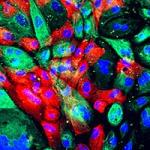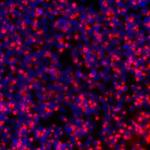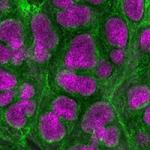
Andre Larochelle, M.D., Ph.D.
Senior Investigator
Regenerative Therapies for Inherited Blood Disorders
NHLBI
Research Topics
The research program focuses on pioneering regenerative therapies for inherited blood disorders, specifically Fanconi anemia (FA). FA is a complex condition characterized by bone marrow failure and a heightened risk of cancer. The program aims to harness the regenerative potential of hematopoietic stem cells (HSCs), which are the cornerstone of the body's blood-forming system. The ultimate goal is to provide permanent solutions for FA patients, for whom safe and effective treatments are currently lacking.
Eltrombopag for the treatment of inherited bone marrow failure
The team has identified eltrombopag (EPAG) as a groundbreaking treatment for FA-associated bone marrow failure. EPAG is a small molecule that mimics thrombopoietin, a key regulator of HSC survival. Clinical trials have shown EPAG to be effective in stimulating residual HSCs, thereby improving blood counts across all cell lineages. The team's unique contribution lies in uncovering how EPAG overcomes HSC inhibition caused by inflammatory factors and improving DNA repair. His program has initiated a phase I/II clinical trial, with interim results showing promising outcomes, including improved blood counts in over 65% of patients. EPAG could be a game-changer, offering the first targeted drug therapy for FA patients.
Gene Therapies for FA
Gene therapies offer a one-time curative approach, bypassing the need for long-term drug treatment or toxicities of allogeneic HSC transplant. However, due to the inherent hypersensitivity of FA HSPCs to DNA damage and inflammatory cytokines, gene therapy of FA presents unique challenges. In a comprehensive research program, the team is integrating three main strategies: Gene Correction Strategies, Engraftment of Gene-Edited HSPCs, and In Vivo Gene Therapy. For Gene Correction Strategies, the program is exploring foamy viral vectors for gene addition in HSCs from FA patients, offering advantages like shorter exposure time and reduced oncogenic risk. Concurrently, alternative CRISPR strategies are being developed to bypass FA cells' faulty DNA repair mechanisms, using chimeric proteins that combine CRISPR-Cas9 and DNA recombinase domains for targeted, DNA damage response-independent integration. For Engraftment of Gene-Edited HSPCs, the group is investigating safer, chemotherapy-free pre-transplant conditioning methods, including monoclonal antibodies and mobilizing agents. Strategies for ex vivo expansion of gene-edited HSPCs focus on promoting self-renewal, suppressing differentiation, and mitigating endoplasmic reticulum stress. Proteomic and transcriptomic screens are underway to identify innate immune pathways that may limit the efficacy of HSPC genetic manipulation. Lastly, under In Vivo Gene Therapy, a novel lipid nanoparticle (LNP) formulation is being optimized for in vivo delivery of CRISPR reagents to HSCs, with biodistribution studies planned to ensure specificity and safety, and proof-of-concept experiments underway in non-human primates to assess therapeutic applicability in FA. The aim is to make gene therapies safer, more efficient, and applicable to a broader range of FA patients.
Cell Therapies for FA
For patients with depleted marrow HSPC reserves who may not respond well to EPAG treatment, de novo generation of HSPCs through induced pluripotent stem cells (iPSCs) offers a promising alternative. These iPSCs are generated from the patient's own cells, corrected for the genetic defect, and then differentiated into HSCs. The challenge lies in ensuring these lab-grown HSCs are as functional as natural ones. The group has developed and patented a scalable protocol, STEMdiff™, for differentiating human iPSCs into HSPCs, although it currently lacks the ability to produce fully mature, engraftable HSPCs. To optimize this, they are exploring three avenues: 1) Ectopic activation of master transcription factors (TFs) identified through CHIP-seq and ATAC-seq methods to improve HSPC generation; 2) Pharmacologic inhibition of key epigenetic factors like EZH1 and EZH2 to accelerate cellular maturation; and 3) Ectopic expression of homing receptors like CXCR4 to enhance HSPC engraftment post-transplantation. These strategies will be tested in various stages of iPSC differentiation and their efficacy confirmed through xenotransplant assays. Concurrently, the team is generating genetically corrected FA-specific iPSCs for hematopoietic differentiation using this optimized approach, with the end goal of producing functionally corrected, engraftable HSPCs for therapeutic applications.
In summary, the group is at the forefront of developing a multi-pronged approach to treat FA, leveraging the power of EPAG, gene therapies, and cell therapies. Each of these avenues holds the promise of revolutionizing the treatment landscape for FA and other inherited blood disorders.
Biography
With a career spanning over three decades, Dr. Larochelle brings a unique blend of expertise in both fundamental hematopoiesis and clinical hematology. His journey began in 1992 when he delved into the intricacies of hematopoietic stem and progenitor cell (HSPC) regulation, culminating in a Ph.D. from the University of Toronto in 1996. Recognizing the transformative potential of bridging basic science with clinical practice, he accelerated his medical education, completing a three-year MD program at McMaster University in 1999. His medical training continued at the Mayo Clinic, followed by a Clinical Hematology Fellowship at the NIH, where he became a board-certified clinical hematologist and stem cell transplant specialist. Dr. Larochelle chose to extend his tenure at the NIH, initially as a post-doctoral trainee and later as a Staff Clinician and Associate Clinical Investigator within the Hematology Branch of the NHLBI. During this period, he spearheaded pivotal projects focused on the mobilization, genetic modification, and expansion of HSPCs for clinical applications in cell and gene therapy. In 2016, he was appointed as a tenure-track investigator, and by 2024, he was promoted to senior investigator. He continues to pioneer innovative strategies in this capacity, utilizing gene therapy and editing technologies to advance regenerative therapies for inherited disorders affecting HSPCs. His contributions to the field have been widely recognized, both through numerous peer-reviewed publications and invitations to speak at prestigious events. He is an active member of the American Society of Hematology and the American Society of Gene and Cell Therapy. He was honored with the 2016 Presidential Early Career Awards for Scientists and Engineers (PECASE), the U.S. Government's highest accolade for early-stage science and engineering professionals.
Selected Publications
- Araki D, Hong SG, Linde N, Fisk B, Redekar N, Salisbury-Ruf C, Krouse A, Engels T, Golomb J, Dagur P, Panicker SR, Kanthi Y, Magnani DM, Wang Z, Larochelle A. cMPL-based purification and depletion of human hematopoietic stem cells: implications for pretransplant conditioning. Blood. 2025;145(25):2978-2991.
- Araki D, Chen V, Redekar N, Salisbury-Ruf C, Luo Y, Liu P, Li Y, Smith RH, Dagur P, Combs C, Larochelle A. Post-transplant G-CSF impedes engraftment of gene-edited human hematopoietic stem cells by exacerbating p53-mediated DNA damage response. Cell Stem Cell. 2025;32(1):53-70.e8.
- Alvarado LJ, Huntsman HD, Cheng H, Townsley DM, Winkler T, Feng X, Dunbar CE, Young NS, Larochelle A. Eltrombopag maintains human hematopoietic stem and progenitor cells under inflammatory conditions mediated by IFN-γ. Blood. 2019;133(19):2043-2055.
- Townsley DM, Scheinberg P, Winkler T, Desmond R, Dumitriu B, Rios O, Weinstein B, Valdez J, Lotter J, Feng X, Desierto M, Leuva H, Bevans M, Wu C, Larochelle A, Calvo KR, Dunbar CE, Young NS. Eltrombopag Added to Standard Immunosuppression for Aplastic Anemia. N Engl J Med. 2017;376(16):1540-1550.
- Larochelle A, Vormoor J, Hanenberg H, Wang JC, Bhatia M, Lapidot T, Moritz T, Murdoch B, Xiao XL, Kato I, Williams DA, Dick JE. Identification of primitive human hematopoietic cells capable of repopulating NOD/SCID mouse bone marrow: implications for gene therapy. Nat Med. 1996;2(12):1329-37.
Related Scientific Focus Areas




Molecular Biology and Biochemistry
View additional Principal Investigators in Molecular Biology and Biochemistry

This page was last updated on Thursday, August 21, 2025